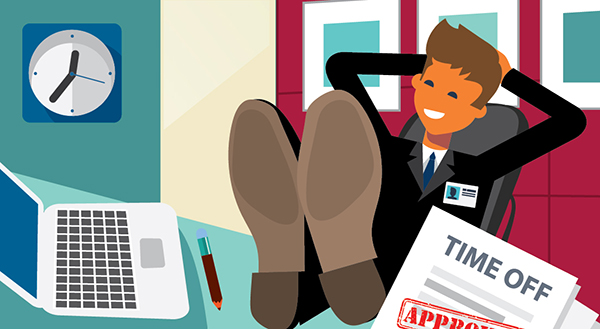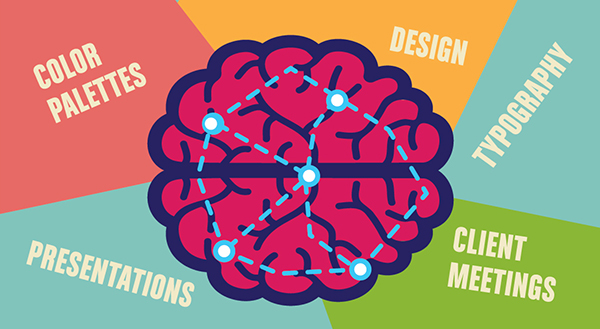
We hate to break it to you, but 70% of your employees are disengaged—probably right this very minute. And did we mention they’re wasting your money? Unmotivated employees cost American companies $350 billion in lost revenue every year.
To save yourself money—and a lot of headaches—you have to know how to motivate your employees. But that’s a tricky thing to do when you’re dealing with creative workers, because you can’t force creativity out of someone. That’s why we’re here to teach you the right motivational techniques.
See what your demotivated employees are really doing at work—and what it’s costing you—in this free, downloadable graphic.
Motivation is more than a “carrot on a stick”

Most managers use a reward-punishment system, providing incentives for success and reprimanding failure. This method relies on external stimuli. The problem? External incentives like salary or punishment aren’t the only sources of motivation—or even the most effective ones.
According to a Gallup poll, only 30% of people making less than $36,000 are emotionally engaged at work. It sounds logical that low pay equals low engagement, but employee engagement actually drops to 28% for those making between $36,000 and $90,000. Even the highest paid workers—earning $90,000 or more—only report 30% engagement.
Translation: throwing money at the problem won’t make it go away. In fact, a survey conducted in Richard Florida’s The Rise of the Creative Class ranks compensation as only the fourth way to motivate people. It got beat out by:
- Challenge and responsibility
- Flexibility
- Stable environment
Designers, writers, and other creatives value the quality of their work and environment more than a fat paycheck. And a variety of factors play into forming a good workplace, meaning you can actually motivate employees without spending money.
Four types of motivation

Intrinsic motivation encompasses employees’ attitudes toward their work. If you’ve ever loved a job so much you’d do it for free, you were intrinsically motivated.
Extrinsic motivation is the tactic most managers use, where employees work to achieve positive results or avoid negative ones. Working on a weekend to earn overtime pay is positive extrinsic motivation; trying not to get demoted for a mistake is negative extrinsic motivation.
Personal motivation reveals how employees value time and people outside the office. One person may stay late on a Friday to avoid working on Saturday. Another may work extra hours to earn time off for a family event. Personal motivation varies between individuals.
Peer motivation uses social influence to encourage or discourage behavior. Competing with a coworker for a promotion is a type of peer motivation.
Intrinsic motivation

Designers choose their career based on their intrinsic motivation to make art and express ideas. As the boss, you have to fuel their desire to work on imaginative projects. Think of it this way—waving external rewards under your employees’ noses might motivate them to work, but it won’t make them more creative. In fact, it may actually distract them.
The University of Michigan teamed up with Stanford psychologists to study how rewards affect motivation. Preschoolers were asked to draw a picture. Group 1 was surprised with a reward at the end of the task, while Group 2 was told at the beginning they would be rewarded for good pictures.
You’d think the kids who knew they were getting a reward do the best job. But the ones who were surprised with a reward actually painted better pictures, because they were making art for art’s sake. And the ones who expected a reward spent less time on their drawings, proving that intrinsic motivation is more closely connected to creativity than extrinsic motivation.
Here’s how you can encourage employees’ intrinsic motivation:

Trust them with challenges
Give them new responsibilities, and tell them you’re confident they can do it. Employees who aren’t encouraged to try new things get stagnant and bored.

Give good feedback
Honest, constructive feedback should happen early and often. Creatives who want to hone their skills will use your input as a catalyst.

Help them learn new skills
Creative people love learning about their craft, so give them time to try new software, read new theories, or attend seminars and classes.

Play to their interests
People are more invested when work interests them. You’ll see better results when you try to match projects to their specialties.

Give them job security
A lot of employees hide great ideas because they’re afraid you’ll shoot them down or even fire them. Instead, create an environment where experimentation is encouraged and failure isn’t final.

Let them have their space
Nothing kills intrinsic motivation like getting interrupted when you’re in the zone. Don’t distract workers who are on a roll.

Allow them to take ownership
Most creatives perform best when they’re emotionally invested in a project. Give your staff space to own their work.
Extrinsic motivation

External motivation still works on creatives—just not the way you think. Rather than being rewards to obtain, external perks improve performance by creating a comfortable, stress-free environment where your employees can be content and focused.
For instance, a monetary bonus won’t make an employee more creative. But it will alleviate money-related stress outside the office—stress you may or may not know about. With their financial needs taken care of, they can give their work undivided attention.
You’ll help creative workers stay extrinsically motivated when you:

Set clear expectations
Trying to hit a moving target can derail employees’ motivation. When your team understands what you’re asking them to do, they’ll be working in a stable environment—which is one of their top three motivators to produce good work.

Define “done”
Creative people thrive on a sense of accomplishment, not ongoing assignments. Define when a project is “done,” so employees can pick the best route to complete it.

Set deadlines
Once you pick a deadline, let your employees self-motivate. Whenever they find their motivation waning, they’ll use the impending deadline to get back on track.

Offer fair compensation and benefits
Money may not be our biggest motivator, but creatives have to eat, too. A good salary, bonuses, and annual raises keep your team focused on work instead of stressing about finances. And good workplace benefits like paid time off or game rooms can prevent burnout.

Create a rewarding environment
Self-Determination Theory states that creative people like working toward positive results, without connecting specific tasks to specific rewards. Rather than offering rewards only on big projects, create an environment where rewards are plentiful and always possible.

Design a comfortable office
Worn-out chairs in tiny, dark offices won’t inspire your employees’ best work. Create a comfy, well-decorated workspace with their input.

Allow flexibility in scheduling
Flex scheduling lets creatives work whenever inspiration strikes. Setting one’s own hours is even connected to physical health; it can improve alertness, mental health, and blood pressure.

Let them take breaks
Statistics show that working too long can actually decrease productivity. Let your employees walk outside, provide a cool break room, or go totally crazy and start a 20% program so your team can recharge.

Say thank you
This is one of the most inexpensive external motivators—it only costs a second of your time. A little gratitude goes a long way to motivate creatives, especially since they often work harder than necessary when they care about a project.

Give them recognition for their work
Creatives always hope their audience will be as big and responsive as possible. Make this a reality by showing off employees’ work on social media or offering to submit it to design blogs.
Personal motivation

Humans have an innate need to self-motivate based on our personal beliefs and goals. As an employer, you need to know what personal values influence your team. You’ll quickly discover each individual has their own set of motivations—and they won’t always align with yours.
You needn’t cater to everyone’s whims. Rather, try to empathize with them through communication to gain a better sense of who they are. It’s important not to make snap judgments based on what you think you see. Someone who doesn’t seem to care about their career may place a high value on family. Demanding they work harder for the sake of the organization won’t help, but focusing on how their work can benefit their family will do wonders.
You can relate personal values to employees’ creativity in several ways:

Ask about their goals
Learning what employees enjoy lets you connect it to their work. For example, someone who travels might like going to a convention in another town.

Listen to them
Listening means paying attention and retaining what you heard. You’ll be surprised how much you learn about your employees if you listen at lunch, on breaks, or at events.

Encourage social interaction
You can’t listen if nobody’s talking, so create a social workplace. Celebrate special occasions, host group outings, or start an open door policy so people can interact freely.

Give the right gift
Sometimes your idea of a reward isn’t what an employee really wants. Picking a reward they like will have the most positive effect on their motivation.

Create a career path
Find out how employees want to grow in their careers, then show them how a project relates to those goals. These advancement opportunities will help them stay focused on the big picture, rather than whether or not they like a project.

Focus on family
You may think of your team as a family, but most of them have real families that take a lot of their time and energy. Spend time getting to know the people who are important to your employees.

Respect their time
Waiting on other people can be exasperating. Respect the importance of employees’ time by arriving to meetings on time, ending early, or being punctual with assignments and reviews.

Create a “no judgment” workplace
Creative people tend to be, well, weird. But that’s what makes them creative. Before you judge them, try to understand why they talk or behave a certain way.

Share your point of view
Once you’ve walked a mile in their shoes, it’s okay to ask others to do the same. Sharing your own personal values, goals, and family life helps your team empathize with you.
Peer motivation

Peer motivation relies on people’s generosity or competitive natures to foster growth. For instance, you’re pretty forgiving if you overcook your own food. But when preparing a meal for others, you’re more likely to make sure everything cooks perfectly. This is prosocial motivation, the innate desire to do something good for others.
Prosocial and intrinsic motivation go hand in hand according to the American Psychological Association. Study participants were asked to create a flyer for a band. Researchers told Group 1 the task was enjoyable, then told Group 2 it was unpleasant. This heightened intrinsic motivation in Group 1 and lowered it in Group 2.
Then, some participants were told the band needed marketing to help earn their living, creating high prosocial motivation. Others were told the musicians had outside jobs to support themselves, lowering prosocial motivation.
The most creative designs came from the group with both high intrinsic and prosocial motivation—in other words, people who enjoyed the work and wanted to help others. You can create that same prosocial motivation in your employees by fostering a “people first” office dynamic.
Here’s how to inspire peer motivation in your staff:

Promote team building
Help them spend time together through team exercises or company traditions, like holiday parties or summer barbecues.

Foster healthy competition
Give prizes for an internal contest, celebrate new records, or stir up some competition outside work with fun activities, like a bowling party or paintball outing.

Assign collaborative projects
Creatives love to bounce ideas off each other, and having a second pair of eyes on a project has its advantages. Let them team up to produce a result that’s greater than the sum of its parts.

Offer conflict mediation
In a 2014 survey, 27% of workers said they were currently experiencing abusive conduct at work—and the perpetrator was usually the boss. It’s your job to nip hostility and bullying in the bud privately, not to air out problems in front of others.

Provide emotional support
Creatives often become self-critical when not performing up to their own expectations. You can motivate them with encouragement, especially when things aren’t going perfect.

Encourage cheerleading
If you want your creative employees to feel like they’re part of the team, celebrate everyone’s victories together.

Involve them across the business
Teaching employees other aspects of the business lets them contribute innovative solutions, teaches them new skills, and establishes camaraderie.
Download and share this guide to motivating your team!

This work by Company Folders, Inc. is licensed under a Creative Commons Attribution 4.0 International License.
Embed this graphic on your site
It’s all you
Creatives are a wildly diverse population, so you’ll have to stay on your toes to keep your team motivated. Take the time to get to know each of your employees and understand where their motivation comes from. Only then can you effectively combine these methods of motivation and inspire your team to create their best work.
Now it’s your turn! Comment below to tell us what makes you excited to go to work, what you value, or what makes you feel the most creative.








This is by far the most detailed and best-presented employee motivation guide I’ve seen. I am not a business owner (yet, hopefully someday I will be), and in the current period of my life cycle, working for someone else, I can safely say that all of this is what we employees want to see and hear from our bosses.
There is a problem however with bigger companies consisting of 300+ employees who cannot be individually taken proper care of by a sole company owner. Hired micro-, macro-managers and supervisors might not find these examples as the right way to go and use their own methods which, trust me, don’t guarantee employee happiness and well-being.
I’d love to view your opinion on the case with bigger companies. Thanks, Vladimir!
Yes, this is one of the best presented article on how to motivate employees.
Well done, Mr. Vladimir Gendelman!
Thank you.
Thanks for this!
Having just moved into our first office space, and taken on several new team members, it’s great to read a post about keeping motivation high.
A very helpful and insightful post. Thanks!
Thanks for this post. I wonder why so many people think that motivating is a natural born skill when they really need some tips to do it properly. I think this post is really useful.
Congratulations for your blog!
Unmotivated employees cost American companies $350 billion in lost revenue every year. What is the cost of replacing all the line managers responsible of this?
Great job with some ideas to motivate workers. You would help a lot of companies!
Great guide, but at the end of the day it has been my experience that money and only money is what most employees are motivated by.
It’s an interesting read and they’re all valid points. Though, as has been pointed out above, money is a huge incentive too.
I really love these ideas to empower your workforce to achieve the sort of place and working life that makes them the best that they can be. A far better way to motivate staff with these positive ideas than trying to beat them down. The true way to motivate and inspire your staff to give the work place, the tools and the sills to drive themselves and the business upwards.
I have worked for all sizes of companies and worked in large companies where they have inspired and managed big teams by bring in processes such as Total Quality Management to help the management teams to manage the work force to grow the business.
Thanks, Vladimir!
I fully agree with Vladimir. It is imperative but also very difficult to motivate employees. It can be such a difficult job that many cannot cope with it. But I, in turn, can say that many managers do not care about the motivation of their employees. Fortunately, at my current job we have an excellent management team that can fully satisfy every employee.
When it comes to creative workers, you want to encourage their curiosity, creativity, and passion. In the workplace, this means encouraging them to do what they love, whether that’s designing or coding. When creative employees are motivated, they’ll work harder to deliver more than what’s expected. Awesome piece, Vladimir!